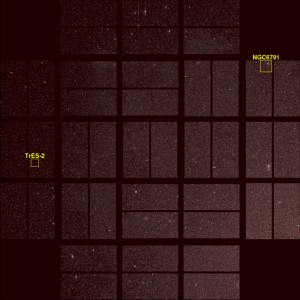Kepler first light – the birth of a new space telescope
Another Asian country with access to space?
April 15, 2009Kick-off for the ESO proposal review marathon
April 21, 2009Hello,
Today NASA announced the successful first light of the Kepler Telescope. I did not describe yet this mission in my blog so that’s a very good opportunity. The Kepler mission is dedicated to monitor 100,000 stars in the sky to search for Earth-size exo-planets. The Kepler spacecraft was launched successful on March 6 2009 and since then the telescope and the spacecraft are being tested.
This is an important mission, part of the Discovery program of NASA, because of the scientific return if it is successful. I mentioned a few weeks ago the possible discovery of a Super-Earth by the French mission called COROT. Kepler telescope will use the same technique, the detection of the dip due to the passing in font of the star of an exo-planets, to detect smaller exo-planets. About 100,000 main sequence stars (mv<14) will be monitored in a 10×10 degrees patch in the sky in the constellation of Cygnus. Kepler has been built to get a photometric precision of 20 ppm (parts per million) for exposure times of 6.5h. For comparison, when Earth occults our Sun, the attenuation is 84 ppm and the transit lasts 13 hours (Van Cleve, Explorer, 6,1,2009). So Kepler could detect a Earth-like or even smaller planets.
The spacecraft is equipped with a 0.95m Schmidt telescope designed to provide wide fields of view with limited aberrations. The instrument mounted on the telescope is a photometer composed of an array of 42 CCDs. The first light (see below) is an important step since it confirms that the telescope is intact (the large lens could have broke due to the vibration during the launch for instance) and the CCD arrays work fine.
Kepler team will not announce the discovery of a Earth-like exoplanet before having detected the transit 3 times. By the end of the 3.5 years mission, the expect to have detected about 50 Earth-like planets assuming that all dwarf stars have at least one such world. So we have to be patient, and cross our fingers! Soon hopefully we will know if terrestrial planets exist around other stars.
Cheers
F.




1 Comment
[…] April 16, 2009 · No Comments Found this tidbit in my GReader today from astronomer, Franck Marchis: Kepler first light – the birth of a new space telescope. […]